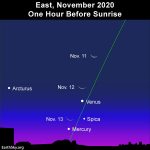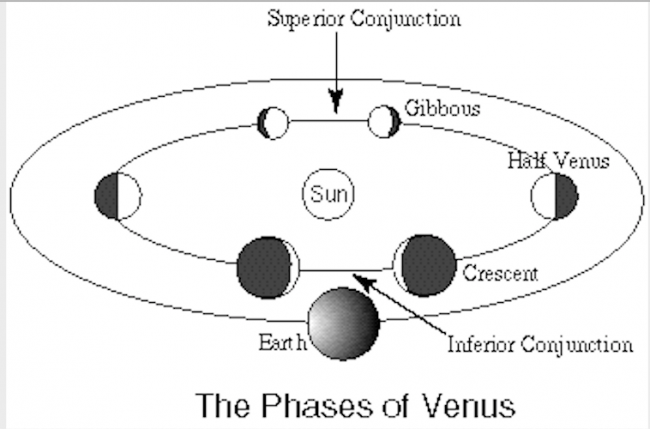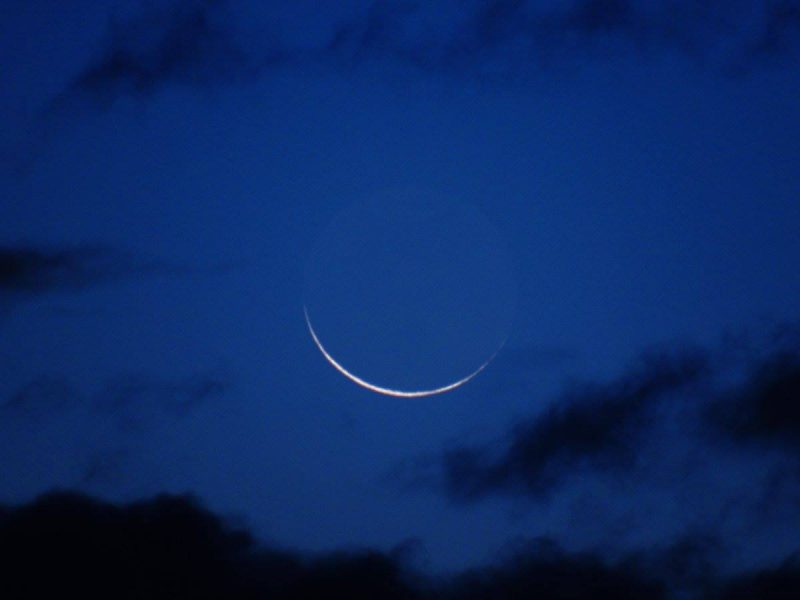
Click here to find out about the Taurid meteor shower
Look eastward before daybreak – November 11, 12 and 13, 2020 – to see the waning crescent moon with the planets Venus and Mercury. You simply can’t miss dazzling Venus, because this world ranks as the third-brightest heavenly body, after the sun and the moon. Look for Mercury beneath Venus and closer to the horizon. Mercury is more easily viewed from the Northern Hemisphere, where it rises well over an hour before sunrise.
Although Venus outshines Mercury by over 20 times, Mercury is nonetheless brighter than a 1st-magnitude star right now. In fact, there’s a 1st-magnitude star in the vicinity of Mercury and Venus on the sky’s dome, named Spica.
Don’t mistake Spica for Mercury or vice versa. Although Mercury is some four times brighter than Spica, Mercury is more deeply buried in the glow of morning twilight. Plus, the moon’s illuminated side more closely points to Mercury than to Spica on November 11, 12 and 13.
If you’re in the Northern Hemisphere, you should also see the orange star Arcturus, to the left of the planets and moon.

View at EarthSky Community Photos. | On November 6, before the moon was sweeping through the scene, Tony Everhardt caught Venus shining like a beacon in the east before sunrise. He wrote, “This is Marblehead Lighthouse in Marblehead, Ohio. Venus in the center and Arcturus to the left if I’m not mistaken.” That’s right, Tony, Venus and Arcturus! Thanks for sharing.
Mercury and Venus are called inferior planets, because these worlds orbit the sun inside Earth’s orbit. Like our moon, inferior planets display the full range of phases, though you need a telescope to see them. On the other hand, superior planets – planets that orbit the sun outside Earth’s orbit – are always full or nearly full.
When the waning crescent moon passes close to Venus and then Mercury in the next few days, you might expect these planets to exhibit a similar phase. (Actually, the moon doesn’t swing close to these planets in space, but closely aligns with them on the sky’s dome.) But no, both of these inner worlds are showing a waxing gibbous phase, not a waning crescent phase.

When Venus is on the far side of the sun, we see a gibbous Venus; but when Venus in on the near (Earth) side of the sun, we see Venus as a crescent. Image via UCLA.
Mercury and Venus show a crescent phase when they’re on the near (Earth) side of the sun, and a gibbous phase when on the far side of the sun. At present, Mercury and Venus reside on the far side of the sun, so they display gibbous phases. Mercury won’t turn into a crescent again until late January 2021, and Venus won’t do so until November 2021.
When Galileo first observed Venus in the early 1600’s, the phases of Venus provided conclusive proof that Venus orbits the sun instead of Earth. Then the Italian astronomer Zupus first observed the phases of Mercury in 1639, providing proof that Mercury orbits the sun as well. The phases of Mercury and Venus helped to bolster the Copernican model of a sun-centered solar system.
The illuminated or daylight side of the waning moon always points eastward, or in the direction of moon’s orbital motion around Earth. Each day, at the same time, note the change of the moon’s position, relative to the backdrop planets and stars of the zodiac. Observe also the beautiful soft glow of earthshine on the dark or nighttime side of the moon.

Dustin Guy in Seattle caught a hint of earthshine on the old moon on the morning of November 6, 2018. When the moon is a thin crescent in Earth’s sky, the Earth is in an almost-full gibbous phase in the moon’s sky. Therefore, the reflected sunlight from bright almost-full Earth lights up the nighttime side of the moon.
Bottom line: These next several days, watch as the waning crescent moon joins up with the planets Mercury and Venus, plus the star Spica, in the eastern predawn/dawn sky.
from EarthSky https://ift.tt/3kglG88

Click here to find out about the Taurid meteor shower
Look eastward before daybreak – November 11, 12 and 13, 2020 – to see the waning crescent moon with the planets Venus and Mercury. You simply can’t miss dazzling Venus, because this world ranks as the third-brightest heavenly body, after the sun and the moon. Look for Mercury beneath Venus and closer to the horizon. Mercury is more easily viewed from the Northern Hemisphere, where it rises well over an hour before sunrise.
Although Venus outshines Mercury by over 20 times, Mercury is nonetheless brighter than a 1st-magnitude star right now. In fact, there’s a 1st-magnitude star in the vicinity of Mercury and Venus on the sky’s dome, named Spica.
Don’t mistake Spica for Mercury or vice versa. Although Mercury is some four times brighter than Spica, Mercury is more deeply buried in the glow of morning twilight. Plus, the moon’s illuminated side more closely points to Mercury than to Spica on November 11, 12 and 13.
If you’re in the Northern Hemisphere, you should also see the orange star Arcturus, to the left of the planets and moon.

View at EarthSky Community Photos. | On November 6, before the moon was sweeping through the scene, Tony Everhardt caught Venus shining like a beacon in the east before sunrise. He wrote, “This is Marblehead Lighthouse in Marblehead, Ohio. Venus in the center and Arcturus to the left if I’m not mistaken.” That’s right, Tony, Venus and Arcturus! Thanks for sharing.
Mercury and Venus are called inferior planets, because these worlds orbit the sun inside Earth’s orbit. Like our moon, inferior planets display the full range of phases, though you need a telescope to see them. On the other hand, superior planets – planets that orbit the sun outside Earth’s orbit – are always full or nearly full.
When the waning crescent moon passes close to Venus and then Mercury in the next few days, you might expect these planets to exhibit a similar phase. (Actually, the moon doesn’t swing close to these planets in space, but closely aligns with them on the sky’s dome.) But no, both of these inner worlds are showing a waxing gibbous phase, not a waning crescent phase.

When Venus is on the far side of the sun, we see a gibbous Venus; but when Venus in on the near (Earth) side of the sun, we see Venus as a crescent. Image via UCLA.
Mercury and Venus show a crescent phase when they’re on the near (Earth) side of the sun, and a gibbous phase when on the far side of the sun. At present, Mercury and Venus reside on the far side of the sun, so they display gibbous phases. Mercury won’t turn into a crescent again until late January 2021, and Venus won’t do so until November 2021.
When Galileo first observed Venus in the early 1600’s, the phases of Venus provided conclusive proof that Venus orbits the sun instead of Earth. Then the Italian astronomer Zupus first observed the phases of Mercury in 1639, providing proof that Mercury orbits the sun as well. The phases of Mercury and Venus helped to bolster the Copernican model of a sun-centered solar system.
The illuminated or daylight side of the waning moon always points eastward, or in the direction of moon’s orbital motion around Earth. Each day, at the same time, note the change of the moon’s position, relative to the backdrop planets and stars of the zodiac. Observe also the beautiful soft glow of earthshine on the dark or nighttime side of the moon.

Dustin Guy in Seattle caught a hint of earthshine on the old moon on the morning of November 6, 2018. When the moon is a thin crescent in Earth’s sky, the Earth is in an almost-full gibbous phase in the moon’s sky. Therefore, the reflected sunlight from bright almost-full Earth lights up the nighttime side of the moon.
Bottom line: These next several days, watch as the waning crescent moon joins up with the planets Mercury and Venus, plus the star Spica, in the eastern predawn/dawn sky.
from EarthSky https://ift.tt/3kglG88

Aucun commentaire:
Enregistrer un commentaire